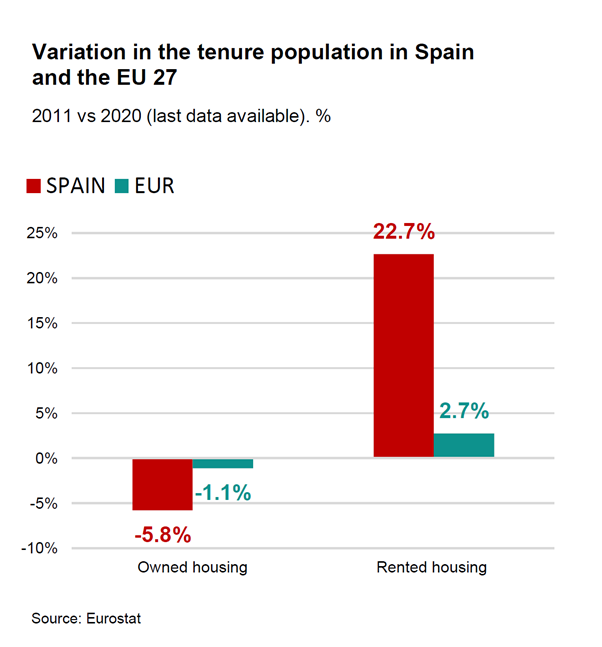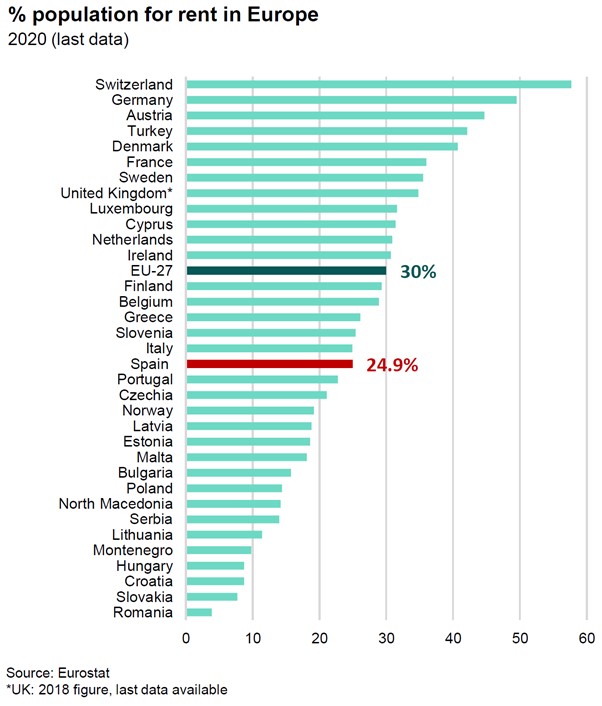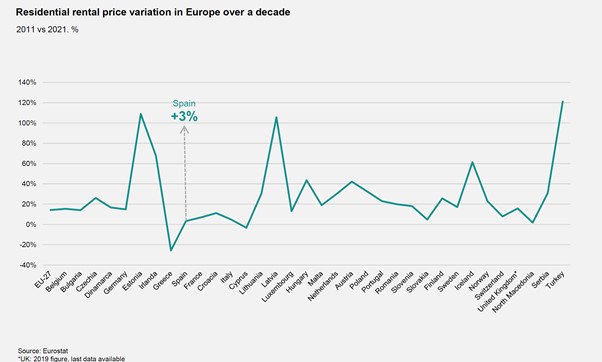Spain rental accommodation growth amongst fastest in Europe
The professionalisation of the sector, an adequate supply, social rental programmes and a change of mentality in Spanish society will consolidate its expansion.
3 minutes to read
The number of people living in rented accommodation in Spain is growing at one of the highest rates in Europe and there is still room to grow.
In Spain, the percentage of the population living in rented housing continues to grow and, although it has not yet reached the European average of 30%, it has increased from approximately 19% in 2007 to almost 25% by the end of 2020.
Cultural changes
The factors that are driving this change of culture from homeowning to renting include an increase of the quality supply, a greater freedom of mobility at work and a greater difficulty of access to financing for purchasing a house.
There is also evidence of an important change in mentality, especially among young people, who are more vulnerable to living in a precarious employment situation, and where renting offers them greater autonomy of movement. However, different social rental programmes are beginning to be promoted to encourage renting, although they are subject to very limited requirements.
Rising renters
Since 2011, Spain's rental population has increased by 22.7% up to 2020, which means that 24.9% of its inhabitants are renting. The European average has since increased by 2.7%, which translates into 30% of the European population living in rented housing.

Despite the increase in Spain, the number of renters is still far from the European average, and even more so from countries where renting is highly consolidated, such as Switzerland, Germany or Austria, where almost half of the population has been living as tenants for years.
In contrast, Eastern European countries such as Romania and Slovakia have the lowest percentage of tenants, with 3.9% and 7.7% respectively.

Financial cost
Among the Spanish population living in rented housing, 36% spend more than 40% of their income on rent. This percentage has fallen considerably compared to five years ago (43.3% of the population), although it is still above of the European average (21.1%).
At the European level, it is the Eastern European countries that spend most of their income on their rent. In Greece nearly 80% of the population spends around 80% of its income on rent payments. In contrast, the Central European region is where the lowest proportion of income is spent on rent, with Germany spending just over 12% of income on housing rent.
Greece has recorded in 2021 a net annual income(1) per person of -41% compared to the EU average (25,000 €/year approx.) while Germany reflects a +31%, according to Eurostat data. Spain is also below, at -15%, although the good economic growth outlook, 4.8% in 2022 and 3.3% in 2023, one of the highest in Europe according to the IMF, could mean that this gap will narrow in the coming years.
(1)Net income per person without children
Rising rents
With regard to the evolution of rental prices, a comparison by European countries over a decade (2011 compared to 2021) shows that rents have increased in most of them, with Estonia and Lithuania standing out, where rental prices have grown by over 100%. At the opposite extreme are Greece and Cyprus, where rents have decreased by 26% and 3% respectively.

In the case of Spain, rents have increased slightly, by 3% since 2011. Despite not being a significant variation, it should be noted that in 2011 Spain was immersed in the economic crisis and at that time the purchase of housing began to decrease sharply, despite the fall in prices.
For this reason, renting became one of the most viable options for many Spanish households, causing prices to rise during the crisis years.
Rental growth in Spain has been similar to that recorded in Italy (5%), Slovakia (5%) or Northern Macedonia (2%). The European average has been considerably higher, at 14% since then.